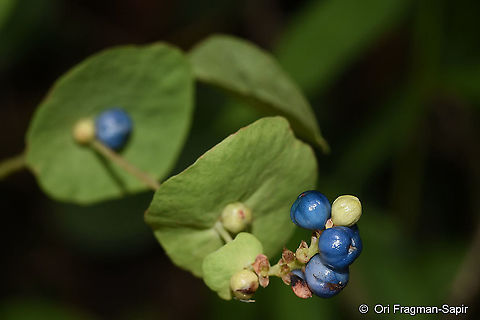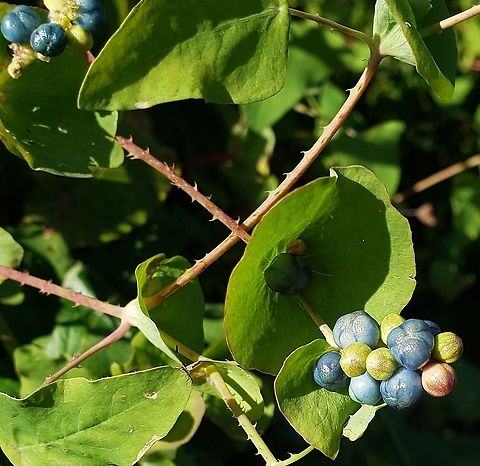
Appearance
''Persicaria perfoliata'' has a reddish stem that is armed with downward pointing hooks or barbs which are also present on the underside of the leaf blades. The light green leaves are shaped like an equilateral triangle and alternate along the narrow, delicate stems. Distinctive circular, cup-shaped leafy structures, called ocreass, surround the stem at intervals. Flower buds, and later flowers and fruits, emerge from within the ocreas. Flowers are small, white and generally inconspicuous. The edible fruits are attractive, metallic blue and segmented, each segment containing a single glossy, black or reddish-black seed.
Habitat
''Persicaria perfoliata'' prefers warm open areas, along the edges of woods, wetlands, stream banks, and roadsides, and uncultivated open fields, resulting from both natural and human causes, dense wooded areas where the overstory has opened up increasing the sunlight to the forest floor. Natural areas such as stream banks, parks, open space, road shoulders, forest edges and fence lines are all typical areas to find ''P. perfoliata''. It also occurs in environments that are extremely wet with poor soil structure.Available light and soil moisture are both integral to the successful colonization of this species. It will tolerate shade for a part of the day, but needs a good percentage, 63-100% of the available light. The ability of ''P. perfoliata'' to attach to other plants with its recurved barbs and climb over the plants to reach an area of high light intensity is a key to its survival. It can survive in areas with relatively low soil moisture, but demonstrates a preference for high soil moisture.
Reproduction
''Persicaria perfoliata'' is primarily a self-pollinating plant , with occasional outcrossing. Fruits and viable seeds are produced without assistance from pollinators. Vegetative propagation from roots has not been successful for this plant. It is a very tender annual, withering with a slight frost, and reproduces successfully until the first frost. ''P. perfoliata'' is a prolific seeder, producing many seeds on a single plant over a long season, from June until October in Virginia, and a slightly shorter season in more northern geographic areas. It can cover as much as 30 feet in a single season, maybe even more in the southern United States.Birds are probably the primary long-distance dispersal agents of ''P. perfoliata''. Transport of seeds short distances by native ant species has been observed. This activity is probably encouraged by the presence of a tiny white food body on the tip of the seed that may be attractive to the ants. These seed-carrying ants may play an important role in the survival and germination of the seeds of ''P. perfoliata''. Local bird populations are important for dispersal under utility lines, bird feeders, fence lines and other perching locations. Other animals observed eating its fruits are chipmunks, squirrel and deer.
Water is also an important mode of dispersal. Its fruits can remain buoyant for 7–9 days, an important advantage for dispersing seed long distances in stream and river environments. The long vines frequently hang over waterways, allowing fruits that detach to be carried away in the water current.
Uses
In traditional Chinese medicine, ''Persicaria perfoliata'' is known as ''gangbangui'' , and is thought to be useful for various remedies in herbal medicine. It can also be used as a fiber or used in rope making.References:
Some text fragments are auto parsed from Wikipedia.